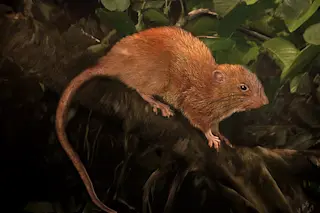This is an illustration of the new species, Uromys vika. (Credit: Velizar Simeonovski, The Field Museum) The mysterious tale of the giant rat of Sumatra was famously "a story for which the world is not yet prepared," according to Sherlock Holmes. Now, after years of searching, researchers have discovered a new tree-dwelling, coconut-piercing species of giant rat in the Solomon Islands—and it measures 18-inches long. The isolated nature of the Solomon Islands, a nation that lies roughly a thousand miles northwest of Australia, have led animals there to evolve in unique ways. More than half of the mammals on the Solomon Islands are found nowhere else on Earth, which helped draw mammalogist Tyrone Lavery of the Field Museum in Chicago. "The Solomon Islands are such a spectacular place to work," Lavery said. "Each isolated island offers an opportunity to discover something new."
On his first trip to the Solomon Islands ...














